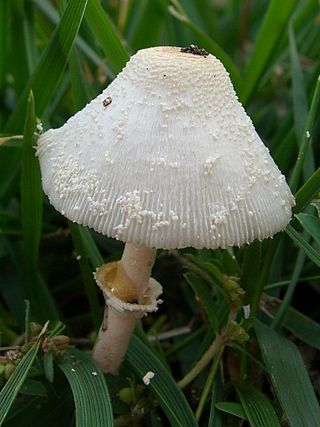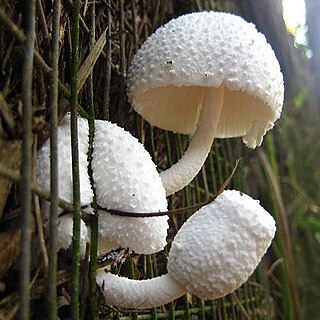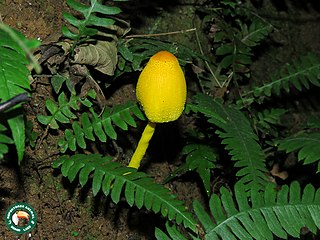
Leucocoprinus cepistipes, is a species of fungus in the family Agaricaceae. It is typically found on wood debris, such as wood chips but may also grow in potted plants or greenhouses. Typical characteristics include a fine-scaled bell-shaped cap, a partial veil, and a tendency to bruise a yellow to brown when handled.

Leucocoprinus brebissonii is a species of mushroom producing fungus in the family Agaricaceae. It is commonly called the skullcap dapperling due to its distinctive pattern on the cap. This mushroom was only thought to be found in Europe but it has since been observed in the Pacific Northwest and may also be found in Asia.

Leucocoprinus cretaceus is a species of mushroom producing fungus in the family Agaricaceae. It is likely tropical in origin although it was first documented in Europe where it was often found growing in greenhouses and bark beds. However many early observations conflate this species with Leucocoprinus birnbaumii or Leucocoprinus cepistipes despite sharing only some superficial similarities. This fungus is quite versatile even for a saprotroph and is often found growing in clusters on woodchips, sawdust and compost heaps as well as directly from the ground or on trees. It may also appear in plant pots and greenhouses in colder countries in which it is not well equipped to survive outside.

Leucocoprinus brunneoluteus is a species of mushroom producing fungus in the family Agaricaceae.
Leucocoprinus magnicystidiosus is a species of mushroom-producing fungus in the family Agaricaceae.
Leucocoprinus longistriatus is a species of mushroom producing fungus in the family Agaricaceae.
Leucocoprinus flavus is a species of mushroom producing fungus in the family Agaricaceae.
Leucocoprinus tricolor is a species of mushroom producing fungus in the family Agaricaceae.
Leucocoprinus castroi is a species of mushroom-producing fungus in the family Agaricaceae.
Leucocoprinus acutoumbonatus is a species of mushroom producing fungus in the family Agaricaceae.
Leucocoprinus pusillus is a species of mushroom producing fungus in the family Agaricaceae.
Leucocoprinus elaeidis is a species of mushroom-producing producing fungus in the family Agaricaceae. In the local language, it is commonly known as elela.
Leucocoprinus subglobisporus is a species of mushroom-producing fungus in the family Agaricaceae.
Leucocoprinus venezuelanus is a species of mushroom producing fungus in the family Agaricaceae.
Leucocoprinus bonianus is a species of mushroom producing fungus in the family Agaricaceae.
Leucocoprinus nanianae is a species of mushroom producing fungus in the family Agaricaceae.
Leucocoprinus fuligineopunctatus is a species of mushroom producing fungus in the family Agaricaceae.
Leucocoprinus microlepis is a species of mushroom producing fungus in the family Agaricaceae.
Leucocoprinus domingensis is a species of mushroom producing fungus in the family Agaricaceae.
Leucocoprinus parvipileus is a species of mushroom producing fungus in the family Agaricaceae.



